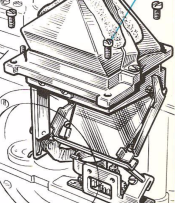I'm guessing there must be an issue with the shutter mech, worn or sticky oil. Although stripping an E is easier than a camera with a Zenit with TTL metering, not sure I want the hassle.
Sounds like it, yes. Something is sticking.
It's been a while since I did the last CLA but I try to make simple list what to do with E and in what order:
1. Before disassebly, if possible, test 1/500 with manual video capable camera with high shutter speed, to see if the slit width is OK. Then you can adjust it (if necessary) during re-glueing of the curtains
2. Adjust mirror to precisely 45 degree angle with the adjusting screw under it. I've used distant scenery with 50mm lens for this. Idea is to adjust until left/right and upper/lower portions of the image in the VF become in focus at precisely the same focus ring distance setting
3. Disasseble camera

4. When pulling the shutter assy away from the camera, try to keep the main drum axle in it's bottom hole and then mark the position of the stopper gear in relation to the drum gear and mirror flip wheel (so you don't have iterate to find the correct tooth during reinstall..)
5. Clean the drum axles and rollers, maybe lube them also a bit. Clean dried grease from bottom gears etc and lube the mirror flipper wheel axle. Note the correct position of all of them in relation to the drum gear! Although the mirror flipper wheel CAN be removed and adjusted with the shutter unit in camera
6. Re-glue the curtains to the drums. It's not necessary to glue the second curtain to the big main drum. It has lot of glue and surface area, it's not going to let go
7. Assemble the shutter unit, but do NOT fully tighten the light baffle
8. Put the shutter into the body, it's much easier if you remove upper main drum bearing beforehand and put the bearing onto the shaft afterwards. Check that the bearing tooth goes to the drum hole.
9. Tighten the shutter unit to the body with a couple of screws. Assemble shutter controlling latch and slot wheel etc, so you can test it. Put a little tension to drum springs
10. Fiddle with the light baffle for 30 minutes so that there is a good spacious slot between it and the camera body for the shutter curtains to run in. Also check sideways, so that the baffle is in the center of the film opening and the edges do not hit the drums! Tighten it down
11. Put mirror/VF assy to camera. Adjust height of the mirror flipper lever in relation to the flipper wheel using B mode. The mirror shall NOT push against mirror foam, there MUST be some play. Otherwise the mirror mech will slow down the flipper wheel which directly slows down or stops the curtains!
12. Fiddle another 30 minutes with the side light baffle, so that it does not hit any curtain roller causing them to slow down
13. Adjust the conical helper spring / gear so, that it is neutral or very slightly pushes the 1st curtain drum + mirror flipper wheel clockwise (looking from the lens mount)
14. There's some play in the mirror assy screw holes. According to point 2., adjust the whole assy back or forth. If your lens did not reach infinity properly (hit the stop before it), put mirror assy towards lens mount (mirror closer to lens) and vice versa
15. Assemble rest of camera and do the final adjusting of curtain tensions







 ) First some good news, I have found a service manual for the Zenit E. It can be found at learncamerarepair.com
) First some good news, I have found a service manual for the Zenit E. It can be found at learncamerarepair.com
